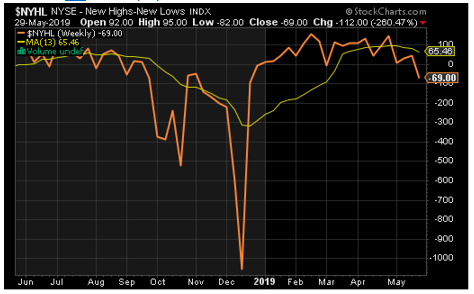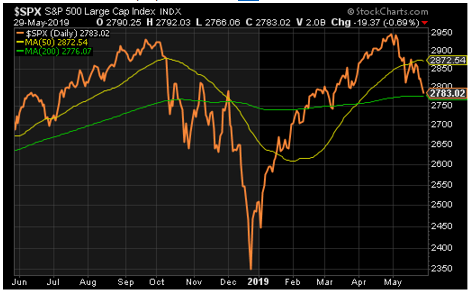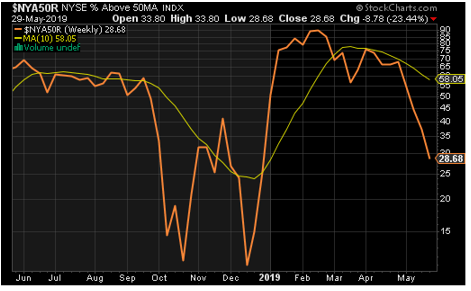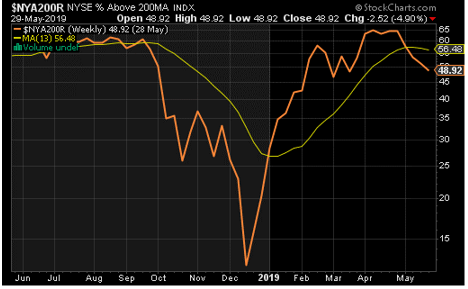The stock market has been misbehaving since the end of April. It could just be a garden-variety pullback, or it might be something more serious. For some thoughts on that, read on.
Ever since the market found a bottom after the global financial crisis of 2008, there have been several scares regarding the sustainability of the great bull market of 2009-2019.
I, for one, don't want to bet against this magnificent bull run, but as time goes by there are cracks in the foundation that require our attention. Here are some examples of said cracks.
Chart 1. New highs minus new lows for the NYSE Composite Index
The simple arithmetic of subtracting the number of stocks making new lows from those making new highs is informative. It indicates market momentum, whether strong or weak. It also indicates market participation - what percent of stocks are hitting highs versus lows.
Today the tally is decidedly negative, and it looks likely to continue this downward path.
Chart 2. Watching for signs of a Death Cross
A Death Cross happens when the short-term momentum of the market crosses below the long-term momentum. This is a rare occurrence, and today we don't have a Death Cross in play. But the gap between these two measures of momentum is narrowing, and I think we should take note.
Chart 3. The percent of stocks trading below their 50 day moving average
The 50 day moving average is an arbitrary marker, but it's widely followed by technical traders, which gives it meaning, at least on a short-term basis. Today only 28% of stocks are trading above their 50 day moving average. That's low, but not a cause for heightened concern because this indicator can reverse course quickly. It bears watching, however.
Chart 4. The cumulative tally of stocks that are going up versus those going down
This is another indicator that's prone to sharp reversals, so we don't want to give it too much weight in our analysis. Nevertheless, the current reading of minus 1,000 is significant. It's further evidence of waning bullish momentum that should be monitored.
Chart 5. The percent of stocks trading below their 200 day moving average
I saved this chart for last because I believe it has important information about the direction of the market. Today the reading is 49% which seems to be a neutral number. But look at the 3-month moving average for this indicator (the yellow line). What it tells me is that the market has not only lost a bit of short-term momentum. It has also lost a fair amount of long-term momentum as well.
Unlike the other indicators I've shown here, this one is slow to move. That means that a rally in the market would not move the needle on this chart unless it continued for several weeks or months. The long-term trend for the market is down.
Final Thoughts
What I have presented here is a relatively short-term view of where this market may be headed next. I'm not predicting an imminent bear market, but I am raising a few warning signs. Success in the stock market gravitates towards those who are prepared for trouble ahead.





